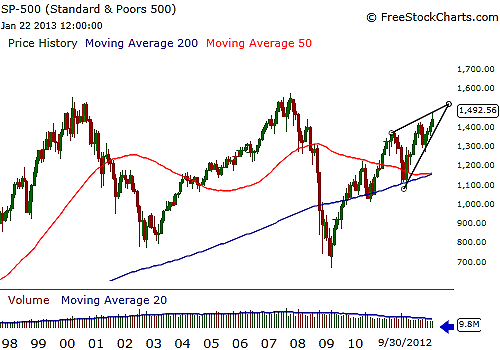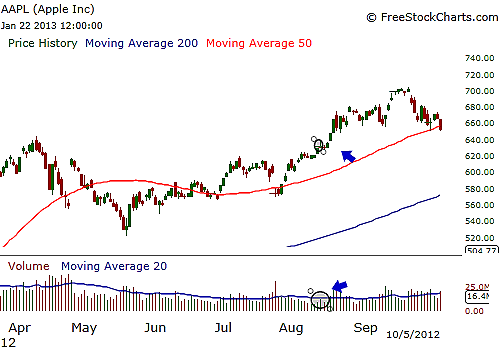
HOT TOPICS LIST
- MACD
- Fibonacci
- RSI
- Gann
- ADXR
- Stochastics
- Volume
- Triangles
- Futures
- Cycles
- Volatility
- ZIGZAG
- MESA
- Retracement
- Aroon
INDICATORS LIST
LIST OF TOPICS
PRINT THIS ARTICLE
by Billy Williams
Just as Charles Darwin put forth the theory of evolution through natural selection, so have the markets and momentum trading evolved with the use of pocket pivots.
Position: Hold
Billy Williams
Billy Williams has been trading the markets for 27 years, specializing in momentum trading with stocks and options.
PRINT THIS ARTICLE
STRATEGIES
Darwin And Momentum Trading
01/23/13 08:44:48 AMby Billy Williams
Just as Charles Darwin put forth the theory of evolution through natural selection, so have the markets and momentum trading evolved with the use of pocket pivots.
Position: Hold
| The last golden age for momentum trading was during the dotcom era in the 1990s, where breakouts were in abundance and the market was tailor-made for William O'Neil's CANSLIM disciples. But then, the market crashed and change inevitably followed. Since early 1999, when the dotcom era burst into flames, the market became trendless and breakouts dried up (Figure 1). The few breakouts that occurred often failed, while those that succeeded lacked the vital follow-through that led to spectacular gains. At a glance, it appears that momentum trading and its different schools of thought are no longer a suitable trading method. In truth, what is needed is a change of application rather than discarding a proven trading method to the ash heap of history. Momentum trading has been a reliable trading approach for the last 90 years, give or take, but like all trading methods, it appears to fall in and out of vogue by being popular during one period in the stock market and then falling out of favor in another. That is because the types of markets to which it is applied to change from upward to downward to sideways. It is the identification of the market type and then matching an appropriate trading method that leads to superior gains. |

|
| FIGURE 1: SPX. After the dotcom era crash in 1999, the market has become trendless, stuck in a tight trading range, but momentum trading has evolved to adapt to this environment. |
| Graphic provided by: www.freestockcharts.com. |
| |
| On a long-term basis, the current market type is a sideways market. If you look back to 1999 to the present on any price chart, you can see that there are clear signs of support and resistance that have kept the long-term time frame in a period of contraction for more than a decade. That said, you can still apply the method within the market's movement between these two price levels, but better yet, you can apply new methods within the overall approach. The markets evolve and if you want to be successful, you need to be mindful of the need for your trading methods to evolve with them. |

|
| FIGURE 2: AAPL. On August 14, 2012, Apple Inc. experienced a pocket pivot buy signal when its volume signature spiked higher than the last 10 trading days while trading in a constructive sideways pattern. It quickly ran up by more than 10% before starting to reverse due to the market's weak follow-through. |
| Graphic provided by: www.freestockcharts.com. |
| |
| This Darwinian approach has been applied to momentum trading from Jesse Livermore to William O'Neil to Gil Morales and Chris Kacher, two of O'Neil's disciples and authors of "Trade Like An O'Neil Disciple." Morales and Kacher have taken momentum trading to a new level by detailing the use of pocket pivots to help capture price's trend as it sets up in a first-stage base. (See Figure 2.) In conventional momentum trading, the trader is looking for a strong stock with solid fundamentals that is establishing a first-stage base pattern, which sets up the condition for a breakaway move to the upside as it trades through the upper limit of the pattern on strong volume. But as mentioned earlier, breakout moves are few and far between and often fail more than they succeed in the current market environment. |
| Realizing this, Morales and Kacher seek to use the pocket pivot technique to capture the upward move before the breakout attempt occurs. To do this, the stock must have constructive sideways action in a base pattern, preferably the first-stage base, with the entry marked by a unique volume signature where volume on the day of the pocket pivot price move must be greater than any down volume day that has occurred over the previous 10 trading days. This setup allows you to do two things: one, you can enter a position earlier while gaining a better price on entry, and two, it allows you to pyramid into a position with greater success of the breakout that follows is successful. If it isn't successful, then the gains you accrue from the initial entry will help you control your losses to a greater degree as well. |
Billy Williams has been trading the markets for 27 years, specializing in momentum trading with stocks and options.
| Company: | StockOptionSystem.com |
| E-mail address: | stockoptionsystem.com@gmail.com |
Traders' Resource Links | |
| StockOptionSystem.com has not added any product or service information to TRADERS' RESOURCE. | |
Click here for more information about our publications!
Comments

|

Request Information From Our Sponsors
- StockCharts.com, Inc.
- Candle Patterns
- Candlestick Charting Explained
- Intermarket Technical Analysis
- John Murphy on Chart Analysis
- John Murphy's Chart Pattern Recognition
- John Murphy's Market Message
- MurphyExplainsMarketAnalysis-Intermarket Analysis
- MurphyExplainsMarketAnalysis-Visual Analysis
- StockCharts.com
- Technical Analysis of the Financial Markets
- The Visual Investor
- VectorVest, Inc.
- Executive Premier Workshop
- One-Day Options Course
- OptionsPro
- Retirement Income Workshop
- Sure-Fire Trading Systems (VectorVest, Inc.)
- Trading as a Business Workshop
- VectorVest 7 EOD
- VectorVest 7 RealTime/IntraDay
- VectorVest AutoTester
- VectorVest Educational Services
- VectorVest OnLine
- VectorVest Options Analyzer
- VectorVest ProGraphics v6.0
- VectorVest ProTrader 7
- VectorVest RealTime Derby Tool
- VectorVest Simulator
- VectorVest Variator
- VectorVest Watchdog
